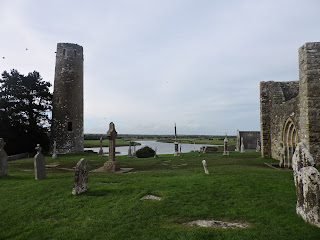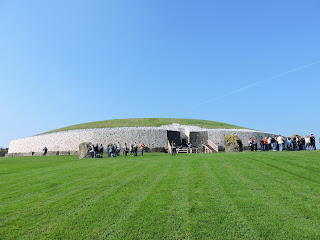This is our academic blog post on our day at the Aran Islands. This blog contains the adventures of Brad, Meghann, Elizabeth, and Eva.
~~~~~~~~~~~~~~~~~~~~~~~~~~~~~~~~~~~~~~~~~~~~~~~~~~~~~~~~~~~~~~~~~~~~~~~~~~~
The Aran Islands are famous for many reasons, not least for the beautiful sweaters produced there which many of us came home with, but also for their beauty and the ruined fortress of Dun Aonghasa. Most of the group cycled around the largest of the Aran Islands, Inishmore, but Elizabeth and Lauren rode in a horse-drawn cart.
The day started out with the golden promise of bright sun rays, but it soon clouded and turned into a very wet day. Although we didn't know it for the first hour or so, we all would be drenched to the bone before the day's end.
 |
| It was sunny in the morning. Truly. |
 |
| Our ferry. |
 |
| The land was getting farther away on the horizon. |
The west of Ireland is mostly boggy or rocky terrain. Neither makes for good farm land, but since the Irish were forced to live there, they had to get all the rock out of the land they were trying to cultivate. This is mostly the reason for the thousands of stone walls throughout the west and on the Aran Islands. As they dragged the rocks out of the field so they could plant it, they built stone walls around the field.
 |
| We're not kidding. Stone walls are in abundance here. |
Since it was so miserable when they reached the top, they didn't look over the cliff edge, but when the rest of the group reached Dun Aonghasa, we crawled out on our stomachs and peeked over the edge to see the waves crashing below.
 |
| Dun Aonghasa |
Dun Aonghasa was seen as a great and powerful fort because of its location. Since it is built on the top of a hill along the edge of a cliff, it has a great defensive and offensive advantage. It is high enough that it would be impossible to attack with a surprise raid. Since it is built on a cliff rather than near the shore, it cannot be attacked from the sea either. The fort Dun Aonghasa was very large and oppressive, enemies would be intimidated by its grandness. The strength and size of the fort would inspire the people and show them the strength of their leader.
Soaked and longing for a warm fireplace, we hiked back down and did some shopping before climbing back into our cart and bikes. Elizabeth and Lauren's driver's name was Martin, and his horse was named Hopper.
 |
| Hopper has one blue eye and one brown one. |
Even the trip back for the girls started out pretty well, but the weather didn't hold long. The rain steadily drenched them for most of the ride back. Although Martin gave them blankets and raincoats to help, the rain was relentless and eventually poured over into every unprotected crack and down their necks and backs. There was no shelter, so their only choice was to push on.
 |
| Every landscape is improved when viewed between the ears of a horse. |
They said goodbye to Hopper and Martian, got some hot chocolate and huddled up in a Pub until our ferry arrived. They never really got warm, just slightly less chilled.
As Elizabeth and Lauren were getting warmed up, the rest of the group was still trapped in the soaking rain. After visiting Dun Aonghasa, they traveled down the island to the Worm Hole.
Here is Eva's account of the Worm Hole:
The Worm Hole is a natural rectangular pool located on the lower cliff, east of Dun Aonghasa. To reach the Worm Hole, we biked through town and meandered through a beaten road between houses. After dropping our bikes off at a gate, we walked for a good twenty minutes or so. We jumped across large rocks and skipped over pointed edges. Following the red arrows across the rock field, we finally reached the edge of the cliff. From there we had to be careful as we walked across the slick rock for ten more minutes. Finally, we came around a corner and saw the Worm Hole. It was larger than I imagined and the scene of waves crashing against the cliff and spilling into the Worm Hole was incredible. The weather was rainy and cold, but I have heard stories of people jumping in for a quick dip. The group walked around for a bit, taking pictures and taking in the beauty of waves crashing. I have never experienced waves in such a majestic way. If you are on the cliff and walk inward, away from the water, there is a bit of an overhang from the cliff above. As the rain came down, we crawled back in that cove and looked out to the Worm Hole and then the ocean as well. Although the Worm Hole was incredible to see, we needed to get back to catch our ferry. We traveled back through the cliffs and rock field, hopped on our bikes and headed to the harbor. I am sure glad I chose to see the Worm Hole. I think it is greater than the title makes it sound.
Of course, as we were leaving the Island the sun came out.
By the time we arrived in Galway, we were just starting to get warmer, but then we stepped out into that coastal wind again and walked a block to arrive at the restaurant, shivering again. It was a humorous sight. We were sitting at candlelit tables, soaking wet and looking like bedraggled street rats. Diana ordered us all hot tea, and we soon got a hot meal, and once we got back to the hostel, we were able to dry off and get warmed up.
This is a video Brad made documenting our entire trip to Galway.









































